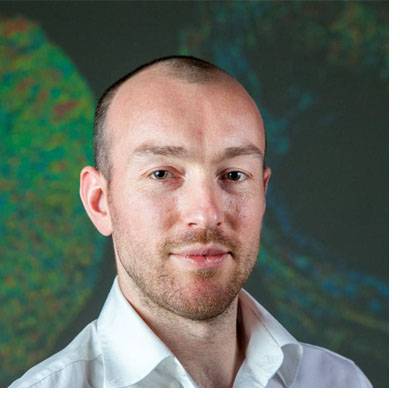We're excited to have innovators and world leaders in the healthcare engineering field join our new Management Board. Over the upcoming weeks, we will be introducing you to the full team.

Cancerous tumours are notoriously varied and complex, which can make knowing how to treat them difficult. With his team at the UCL Centre for Advanced Biomedical Imaging (CABI), Simon is developing new non-invasive imaging techniques to better understand tumours and how to tackle them.
Simon is a Wellcome Trust Senior Research Fellow within CABI, where he leads the Cancer Imaging Group (CIG). The CIG combines novel and state-of-the-art imaging techniques to understand cancer growth, development and death. Their ultimate goal is to translate these tools into a clinical setting.
A key focus of Simon’s research is how easily different drugs can penetrate tumours. Along with Rebecca Shipley (Director, Institute of Healthcare Engineering and UCL Mechanical Engineering), Simon has designed a technique which can create highly-detailed 3D models of individual tumours and simulate drug delivery in order to predict effectiveness. This pioneering technology has the potential to benefit patients by allowing clinicians to determine their most effective therapeutic plan and minimise adverse side effects. The project was funded by the Rosetrees Trust Interdisciplinary Prize.
What is the highlight of your career so far?
The best part so far was securing a Wellcome Trust fellowship, which gave me the financial freedom to pursue ideas that I couldn’t have otherwise, and to build up my group. I’m really proud of the work we’ve done in that time, where we’ve combined imaging, mathematical modelling and machine learning to develop methods for predicting treatment response in tumours.
Where do you see your field of research in 10 years, in terms of scientific developments and advances?
I’m optimistic that imaging biomarkers will increasingly find their way into routine clinical use, and I suspect machine learning will play a key role in that. Likewise, machine learning is widely predicted to transform radiology, alongside many other disciplines, and it will be interesting to see what form that takes.
What would you like the public to know about your research?
It’s very satisfying when you can give people a sense of awe by showing them something new, or in a way that they hadn’t considered before. Some of our large-scale simulations of biological tissues have the ability to do that, particularly when you can immerse people in virtual reality. But more generally I think it’s really important to give people a good understanding of what science is, and how beneficial a scientific worldview can be.
What is the most valuable lesson you’ve learnt during your career so far?
To work regular office hours. Obviously that’s not always possible, but you can very quickly become burnt out and unproductive if you don’t have a good work-life balance. Working in science can be pressured, but also quite addictive, and sometimes you have to force yourself away from the lab.
 Close
Close

